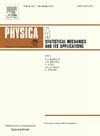通过 Leggett-Garg 不等式实现量子点器件中电子传输的量子化:非平衡格林函数方法
IF 2.8
3区 物理与天体物理
Q2 PHYSICS, MULTIDISCIPLINARY
Physica A: Statistical Mechanics and its Applications
Pub Date : 2024-10-15
DOI:10.1016/j.physa.2024.130160
引用次数: 0
摘要
尽管利用纳米制造工具可以在量子点(QD)器件中实现对电子态的相干操纵,但人们往往很难理解这些纳米电子器件的量子力学行为达到何种程度。因此,在新兴的量子技术领域,见证它们的非经典性质仍然至关重要,因为电子态的相干动力学在其中发挥着至关重要的作用。在此背景下,我们采用了莱格特-加尔格不等式(LGI)的一般框架,因为它允许通过各种两时间相关函数来区分纳米结构中的经典和量子传输。利用在两个不同时间的局部电荷检测,我们在此从理论上研究了在马尔可夫和非马尔可夫动力学条件下,不同的器件配置和参数是否存在对原始 LGI 的量子违反。通过精确求解量子朗格文方程,以非平衡态格林函数 (NEGF) 的形式导出了 LGI 中的两时间相关器。目前对与储层相互作用的量子系统的非马尔可夫动力学的研究,对于理解超快瞬态体系中的弛豫现象,特别是模拟高速量子器件的弛豫现象具有重要意义。通过考虑电极处的电平展宽以及非马尔可夫记忆效应,我们有可能捕捉到有限储层相关时间的影响。此外,在我们的计算中不再强加大偏压限制,因此我们可以安全地考虑电子贮水池之间的有限偏压。我们的方法很可能会为其他量子多体系统的量子化开辟新的可能性。本文章由计算机程序翻译,如有差异,请以英文原文为准。
Quantumness of electron transport in quantum dot devices through Leggett–Garg inequalities: A non-equilibrium Green’s function approach
Although coherent manipulation of electronic states can be achieved in quantum dot (QD) devices by harnessing nanofabrication tools, it is often hard to fathom the extent to which these nanoelectronic devices can behave quantum mechanically. Witnessing their nonclassical nature would thus remain of paramount importance in the emerging world of quantum technologies, since the coherent dynamics of electronic states plays there a crucial role. Against this backdrop, we resort to the general framework of Leggett–Garg inequalities (LGI) as it allows for distinguishing the classical and quantum transport through nanostructures by way of various two-time correlation functions. Using the local charge detection at two different time, we investigate here theoretically whether any quantum violation of the original LGI exists with varying device configurations and parameters under both Markovian and non-Markovian dynamics. Two-time correlators within LGI are derived in terms of the non-equilibrium Green’s functions (NEGFs) by exactly solving the quantum Langevin equations. The present study of non-Markovian dynamics of quantum systems interacting with reservoirs is significant for understanding the relaxation phenomenon in the ultrafast transient regime to especially mimic what happens to high-speed quantum devices. We can potentially capture the effect of finite reservoir correlation time by accounting for level-broadening at the electrodes along with non-Markovian memory effects. Furthermore, the large bias restriction is no longer imposed in our calculations so that we can safely consider a finite bias between the electronic reservoirs. Our approach is likely to open up new possibilities of witnessing the quantumness for other quantum many-body systems as well that are driven out of the equilibrium.
求助全文
通过发布文献求助,成功后即可免费获取论文全文。
去求助
来源期刊
CiteScore
7.20
自引率
9.10%
发文量
852
审稿时长
6.6 months
期刊介绍:
Physica A: Statistical Mechanics and its Applications
Recognized by the European Physical Society
Physica A publishes research in the field of statistical mechanics and its applications.
Statistical mechanics sets out to explain the behaviour of macroscopic systems by studying the statistical properties of their microscopic constituents.
Applications of the techniques of statistical mechanics are widespread, and include: applications to physical systems such as solids, liquids and gases; applications to chemical and biological systems (colloids, interfaces, complex fluids, polymers and biopolymers, cell physics); and other interdisciplinary applications to for instance biological, economical and sociological systems.

 求助内容:
求助内容: 应助结果提醒方式:
应助结果提醒方式:


